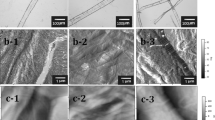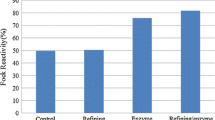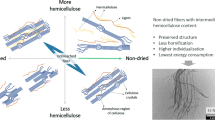Abstract
Hardwood bleached Kraft pulp was treated with an endoglucanase prior to Valley beating. The Valley-beaten pulp slurry was further ground with a particle grinder in order to evaluate the effect of enzyme beating on preparation of microfibrillated cellulose (MFC). The time required to make 100 mL Canadian Standard Freeness pulp slurry was greatly reduced by enzyme pre-treatment. The viscosity of the enzyme-beaten MFC slightly increased with grinder pass number; however, the rate of change in viscosity was much lower than that of non-enzyme-beaten MFC. The crystallinity of MFC decreased with grinder pass number for both cases. The drainage of the pulp slurry containing enzyme-beaten MFC was higher than that of the pulp slurry containing non-enzyme-beaten MFC. Further, the enzyme-beaten MFC subjected to the 10 passes grinding had the same tensile index as the MFC subjected to the 15 passes grinding. Thus, the mechanical energy for MFC manufacturing can be greatly reduced with enzyme beating.










Similar content being viewed by others
References
Afra E, Yousefi H, Hadilam MM, Nishino T (2013) Comparative effect of mechanical beating and nanofibrillation of cellulose on paper properties made from bagasse and softwood pulps. Carbohyd Polym 97(2):725–730
Ahn EB, Hong SB, Kim KJ, Eom TJ (2015) Micro-fibrillated cellulose preparation with enzyme beating pretreatment and effect on paper strength improvement. J Korea TAPPI 47(6):57–65
Ankerfors M (2012) Microfibrillated cellulose: energy-efficient preparation techniques and key properties. Licentiate thesis, KTH Royal Institute of Technology
Bharimalla AK, Deshmukh SP, Patil PG, Vigneshwaran N (2015) Energy efficient manufacturing of nanocellulose by chemo- and bio-mechanical processes: a review. World J Nano Sci Eng 5(4):204–212
Bhatnagar A, Sain M (2005) Processing of cellulose nanofiber-reinforced composites. J Reinf Plastic Compos 24(12):1259–1268
Chakraborty A, Sain M, Kortschot M (2005) Cellulose microfibrils: a novel method of preparation using high shear refining and cryocrushing. Holzforschung 59(1):102–107
Chun SJ, Lee SY, Doh GH, Lee S, Kim JH (2011) Preparation of ultrastrength nanopapers using cellulose nanofibrils. J Ind Eng Chem 17(3):521–526
Gonzalez I, Vilaseca F, Alcala M, Pelach MA, Boufi S, Mutje P (2013) Effect of the combination of biobeating and NFC on the physico-mechanical properties of paper. Cellulose 20(3):1425–1435
Henriksson M, Henriksson G, Berglund LA, Lindström T (2007) An environmentally friendly method for enzyme-assisted preparation of microfibriilated cellulose (MFC) nanofibers. Eur Polymer J 43(8):3434–3441
Hon DSS, Shiraishi N (1990) Wood and cellulosic chemistry. Marcel Dekker Inc., New York, pp 633–650
Jang JH, Kwon GJ, Kim JH, Kwon SM, Yoon SL, Kim NH (2012) Preparation of cellulose nanofibers from domestic plantation resources. J Korean Wood Sci Technol 40(3):156–163
Kajanto I, Kosonen M (2012) The potential use of micro- and nano-fibrillated cellulose as a reinforcing element in paper. J Sci Technol For Prod Processes 2(6):42–48
Kim HJ, Jo BM, Lee SH (2006) Potential for energy saving in refining of cellulose-treated Kraft pulp. J Ind Eng Chem 12(4):578–583
Kim KJ, Jung JD, Jung SE, Ahn EB, Eom TJ (2015) Enzyme activity and beating properties for preparation of microfibrillated cellulose (MFC). J Korea TAPPI 47(1):59–65
Lavoine N, Desloges I, Dufresne A, Bras J (2012) Microfibrillated cellulose-Its barrier properties and application in cellulosic materials: a review. Carbohyd Polym 90(2):735–764
Nechyporchuk O, Pignon F, Belgacem MN (2015) Morphological properties of nanofibrillated cellulose produced using wet grinding as an ultimate fibrillation process. J Mater Sci 50(2):531–541
Pääkkö M, Ankerfors M, Kosonen H, Nykänen A, Ahola S, Österberg M, Ruokolainen J, Laine J, Larsson PT, Ikkala O, Lindström T (2007) Enzymatic hydrolysis combined with mechanical shearing and high-pressure homogenization for nanoscale cellulose fibrils and strong gel. Biomacromolecules 8(6):1934–1941
Qing Y, Sabo R, Zhu JY, Agarwal U, Cai Z, Wu Y (2013) A comparative study of cellulose nanofibrils disintegrated via multiple processing approaches. Carbohyd Polym 97(1):226–234
Rodionova G, Eriksen Ø, Gregersen Ø (2012) TEMPO-oxidized cellulose nanofiber films: effect of surface morphology on water resistance. Cellulose 19(4):1115–1123
Ryu JH (2013). Fundamental properties of nanofibrillated cellulose in suspension and mat states. A dissertation for the degree of doctor of philosophy, Seoul National University, Republic of Korea
Saito T, Kimura S, Nishiyama Y, Isogai A (2007) Cellulose nanofibers prepared by TEMPO-mediated oxidation of native cellulose. Biomacromolecules 8(8):2485–2491
Segal L, Creely JJ, Martin AE, Cornrad CM (1959) An empirical method for estimating the degree of crystallinity of native cellulose using the X-Ray diffractometer. Text Res J 29(10):786–794
Siddiqui N, Mills RH, Gardner DJ, Bousfield D (2011) Production and characterization of cellulose nanofibers from wood pulp. J Adhes Sci Technol 25(6–7):709–721
Siqueira G, Tapin-Lingua S, Bras J, Perez DDS, Dufresne A (2010) Morphological investigation of nanoparticles obtained from combined mechanical shearing, and enzymatic and acid hydrolysis of sisal fibers. Cellulose 17(6):1147–1158
Siro I, Plackett D (2010) Microfibrillated cellulose and new nanocomposite material: a review. Cellulose 17(3):459–494
Tanpichai S, Sampson WW, Eichhorn SJ (2013) Microfibrillated cellulose reinforced poly (vinyl alcohol) composites. Adv Mater Res 747:359–362
Vartiainen J, Pöhler T, Sirola K, Pylkkänen L, Alenius H, Hokkinen J, Tapper U, Lahtinen P, Kapanen A, Putkisto K, Hiekkataipale P, Eronen P, Ruokolainen J, Laukkanen A (2011) Health and environmental safety aspects of friction grinding and spray drying of microfibrillated cellulose. Cellulose 18(3):775–786
Wang B, Sain M, Oksman K (2007) Study of structural morphology of hemp fiber from the micro to the nanoscale. Appl Compos Mater 14:89–103
Yoo SJ, Hsieh JS (2010) Enzyme-assisted preparation of fibrillated cellulose fibers and its effect on physical and mechanical properties of paper sheet composites. Ind Eng Chem Res 49(5):2161–2168
Zhang ZJ, Chen YZ, Hu HR, Sang YZ (2013) The beatability-aiding effect of Aspergillus niger crude cellulase on bleached Simao pine Kraft pulp and its mechanism of action. BioResources 8(4):5861–5870
Acknowledgments
This research was supported by Basic Science Research Program through the National Research Foundation of Korea (NRF) funded by the Ministry of Education, Science and Technology (NRF- 2016R1D1A3A03918987).
Author information
Authors and Affiliations
Corresponding author
Rights and permissions
About this article
Cite this article
Kim, KJ., Lee, J.M., Ahn, EB. et al. Effect of enzyme beating on grinding method for microfibrillated cellulose preparation as a paper strength enhancer. Cellulose 24, 3503–3511 (2017). https://doi.org/10.1007/s10570-017-1368-9
Received:
Accepted:
Published:
Issue Date:
DOI: https://doi.org/10.1007/s10570-017-1368-9




